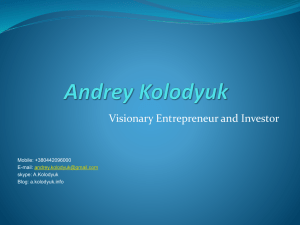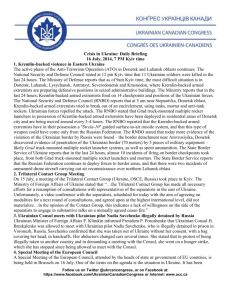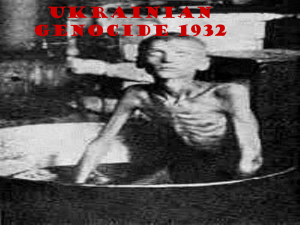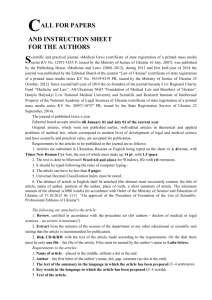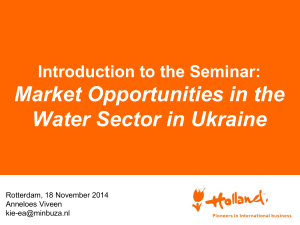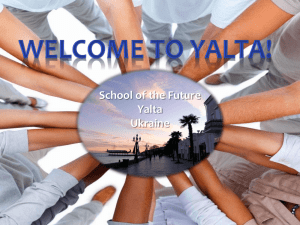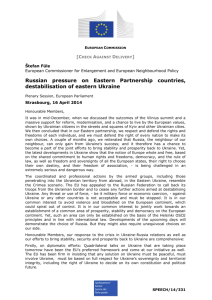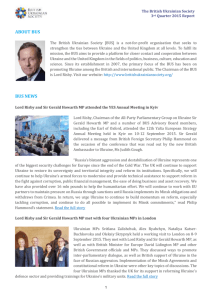Document
advertisement
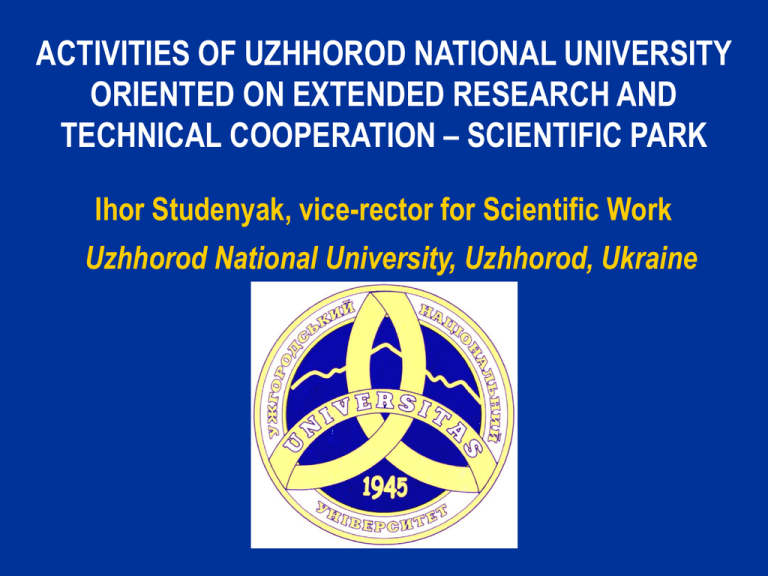
ACTIVITIES OF UZHHOROD NATIONAL UNIVERSITY ORIENTED ON EXTENDED RESEARCH AND TECHNICAL COOPERATION – SCIENTIFIC PARK Ihor Studenyak, vice-rector for Scientific Work Uzhhorod National University, Uzhhorod, Ukraine 1. General information about Uzhhorod National University The state higher educational institution of the IV accreditation level; The Ministry of Education and Science of Ukraine Licence AB №175907; Year of establishment – 1945; Number of faculties – 18; Number of students –12000 students; Forms of studies: day-time, extra-mural, continuing post diploma studies on the state budget funding and on the contract basis. Educational qualification levels: the Bachelor's, the Specialist's, the Master's programs. Number of professors, Doctors of Sciences – 105; Number of Associate Professors, Candidates of Sciences – 450; Number of Honoured Workers of Science and Technology, Honoured Educationalists, Physicians, Inventors – over 50. Post graduate courses, preparatory department and preparatory courses, Refresher courses. The University maintains international cooperation with 62 higher educational establishments of the world. University Address: 46, Pidhirna St., Uzhhorod, Ukraine, 88000. Rector's office: 46, Pidhirna St., Uzhhorod, Ukraine, 88000 Tel/ Fax. 38 (03122) 3 33 41, 3 33 46; Tel. 38 (03122) 3 42 02 E-mail: adm@univ.uzhgorod.ua Web-site: www.univ.uzhgorod.ua The scientific work of Uzhhorod National University is aimed at performing the fundamental and applied research projects in the priority directions of the development of science and technology, at the support, development and effective use of the University's R&D potential, at training high quality scientific and pedagogical staff, at increasing the teaching and educational process standards level at the integration of the education and science in the context of the Bologna process major guidelines, officially acceded to by Ukraine. Institute of Carpathian Studies The institute was created in 1992. Institute performed fundamental and applied research directed at: ■ the study of history, archaeology, ethnography, history of art of Transcarpathian region in its interconnection with the Carpathians region ■ the development of practical recommendations in ethnopolitical and ethno-social questions ■ the research of history of Ukrainian diaspora in Europe and America ■ the development of regional manuals for the educational network of Transcarpathian region Institute of Solid State Physics and Chemistry The Institute was founded in 1992 on the basis of Problem research laboratory for synthesis and research of complex semiconductor compounds. The basic directions of its activities are: ■ the physics of phase transitions and critical phenomena in multicomponent structures; ■ the technology of preparation of new crystalline, glassy and thin-film functional materials; ■ the primary transformers and functional elements for the detectors of optical, thermal and acoustic radiation; ■ the optolectronic systems of registration and information treatment. Institute of State Administration and Regional Development The institute was created in1997. The basic directions of its activities are: ■ the elaboration of the programs for qualification increasing and preparation of public servants in different categories; ■ the organization of educational courses; ■ the consultative, expert, informatively technical assistance to the organs of state administration, local self-government, public organizations, business structures; ■ the conducting of research for state administration, regional policy and development, local self-government. Institute of Brain The Institute was created in 2006. The Institute executes fundamental and applied research directed at: ■ the improvement of diagnostics and treatment of vascular diseases of brain and spinal cord; ■ the study of possibilities of epilepsy surgical treatment; ■ the treatment of pain syndromes; ■ the complex research of infectious-inflammatory, immune and degenerative nervous diseases; ■ the treatment of new pharmacology of the nervous system; ■ the improvement of intensive therapy for patients with lesion of nervous system; ■ the study of new methods of surgical treatment of patients with lesion of nervous system. Institute of Ukrainian Studies The Institute of Ukrainian Studies was founded in 2007. The basic directions of scientific and practical activities are: ■ the complex research of problems of Ukrainian history, political science, sociology, language, literature, folklore; ■ the realization of direct contacts and joint scientific research with Ukrainedirected scientific - pedagogical, scientific and scientific-educational institutions of neighboring countries (Slovakia, Romania, Serbia, Poland, the Czech Republic); ■ the organization of dialectology and folklore expeditions for the research of Ukrainian ethnographic acres and places of compact residence of Ukrainians. Institute of Phytotherapy The Institute was created in 1992. The main directions of its activities are: ■ the development of phytopreparations for the prevention and treatment of patients with internal organs pathology, caused by small doses of ionizing radiation influence; ■ the issue of developed phytopreparations and phytoproducts; ■ the development of computer expert systems of diagnostics, prognostication and optimal phytotherapy; ■ the development of new instrumental diagnostic methods of pre-tumour and tumour states. Institute of Analytical Technique Facilities The Institute created in 2008. The basic directions of its activities are: ■ the implementation of fundamental, scientific-research, research-design, scientific-industrial works and services; ■ the development of new element base of machine-building with the application of microelectronic technologies; ■ the development of analytical devices among which there are devices of gas analysis for the control and protection of environment, for the special technological processes of labour protection, accident prevention; ■ the production and realization of research models of scientific and technical production, elaboration of technical documentation for mass-production. Laboratory of Physical Electronics with Space Research Department The Laboratory, opened in 1965, was the first scientific institution at the university. The Laboratory include: - The department of emission electronics is the research of conformities and mechanisms of the phenomena of emissions at the irradiation of the surface of solids and tapes by ions, electrons and photons. - The department of quantum electronics studies physics processes in plasma of high pressure gas lasers on excimer and other molecules. - The department of electron-atomic collisions deals the research of processes of inelastic со-оperations of electrons with the normal and metastable atoms of metals, and also with the molecules of nucleic acids and metalhalogenides. - The department of space research conducts the observation of artificial and natural space bodies, research of surrounding space. Laboratory of Natural Ecosystems Safety The Laboratory was created in 1993. The basic directions of its activities are: ■ the forming of computer data bank of the naturе protected fund of Transcarpamian region and development of its perspective network: ■ the research and inventory of flora and fauna of the nature protected territories; ■ the creation of the computer data bank of these types of flora and fauna of Transcarpathian region, brought to the Red Book of Ukraine, and also those that are the under the threat of their disappearance; ■ the monitoring research of bioecological features of the population of most imgressionable rareand vanishing types of plants and animals. Hungarology Center The Hungarology Center of Uzhhorod National University was founded in 1988. The basic directions of its scientific research are: ■ Ukrainian-Hungarian interlingual (interdialectal) contacts; ■ interliterary and interethnic communications; ■Hungarian dialects of Transcarpathian region and linguogeography. Center of Family Medicine ■ ■ ■ ■ ■ ■ The Center was created in 2002. The aim and functions of the Centre are: the providing of studies of interns and students of appropriate specialities; the scientific describing and providing of target clinical examination; the introduction of clinical protocols of diagnostics and treatment, the improvement of medical service quality; the co-ordination of work for stage-by-stage introduction of family medicine the region; the development, edition and realization of educational and methodical materials for students, interns and doctors; the conducting of scientific research, experimental and inculcating research in the field of information and telecommunication technologies in the system of education and health protection. Center for the Trial of New Medications The center was created in 2005 with the purpose of development of new methods of treatment of patients with oncologic pathology, elaboration and introduction into clinical practice of new schemes and modes of chemotherapy of malignant neoplasm. The basic directions of its activities are: ■ the trial of newantitumoral medication of domestic and foreign production; ■ the research of new combinations of known medications, used in oncology, and also in studying of the mechanisms of tumour resistance to chemopreparations. 2. International scientific and R&D cooperation of UzhNU In 2010 Uzhhorod National University maintained international cooperation with 76 scientific institutions of Slovakia, Hungary, Romania, Poland, Czech Republik, Croatia, Serbia, Great Britain, Germany, Russia, Canada, China, Syria, India, Italy, France, the USA. Such a wide international cooperation of the university promotes the expansion of research in different fields of studies,first and foremost in physics, chemistry, biology, medicine, and the problems of the Carpathian region. During 2005-2009 years UzhNU took part in 8 international scientific programs and projects, among which: - The project “Sustainable exploitation of bioactive components from the Black Sea Area in traditional foods” (according to the 7th EU Framework Program). Co-coordinator of project – University of Bologna, leader of project – Prof. Luigi Filippo D’Antuano; leader of project from UzhNU – Prof. Boyko N.V.) The executors of this project are 13 scientific institutions and organizations from Italy, United Kingdom, Portugal; Greece, Turkey, Bulgaria, Romania, Ukraine, Georgia, Serbia and Russia. - Program INTAS “Modernization of existent network of the space geodesy Ukrainian stations”; - Ukrainian-Canadian Program “Community Economic Development Project”; - The EU Program-Jeanne Monnet “Development and teaching of study course “Expansion to east and policy of neighbourliness of EU”; - SCOPES Project "Strengthening of researches in virgin forests in economic use, as the basis of biodiversity and sustainable use of forest resources in the Ukrainian Carpathians"; - project Tempus-Tasis within the framework of Neighbourliness Program of Hungary, Slovakia and Ukraine “Development of Beregovo Transboundary Polder system in the river Tysa basin”; - project Tempus-Tasis “Improvement of the three-level system of education in the social work area in the European countries”; - project NATO “Association of separate TV&media networks in unique "Ukrmednet" with integration of social services”. Within the framework of international scientific and technical cooperation MES of Ukraine during 2005-2009, UzNU executed 7 UkrainianHungarian projects, 4 Ukrainian-Lithuanian projects, 2 Ukrainian-Slovakian projects, Ukrainian-Indian project, Ukrainian-Bulgarian project, UkrainianTurkish project, Ukrainian-French project. Ukrainian-Hungarian projects: - "Diagnostics of nano-dimensional phase extractions in optical glasses based on resonance Raman spectroscopy"; - "Researches and development of functional, sensible to external -"Laser annealing and monitoring of structural changes in the optical and holographic media based on chalcogenide glasses while recording Raman spectra at different excitation energies"; - "Nanotechnology of multicomponent glasses and composites for photonics and biotechnology"; - "Nosocomial infections of the Ukrainian-Hungarian border territories population: modern state and effective ways of their prophylaxis"; - "Research and development of optical materials and structures for biosensors"; - "Immunemodulatory role of commensal microflora: new mechanisms, potential target cells and prospects of using". Ukrainian-Lithuanian projects: -“Obtaining and study of materials for information technology, acoustoelectronics, optoelectronics and nanoelectronics"; - "Search and study of physical and chemical properties of materials for solid state ionic"; - "Layer nonlinear chalcogenide crystals and nanocomposites for acoustoelectronics and signal processing"; - "Electronic properties and phase transitions in semiconductor chalcogenides of phosphorus". Ukrainian-Slovakian projects: - "Investigations of disordering processes caused by ion implantation and dimensional effects in superionic conductors with arhyrodyte structure“; - "Transformation of Ukrainian and Slovak omastycons of posttotalitarian period“. Ukrainian-Indian project: "Study of metal - amorphous chalcogenides for its application in electronics“. Ukrainian-Bulgarian project: "Experimental and theoretical spectroscopic study of light-induced conversions in multicomponent glassy semiconductors“. Ukrainian-Turkish project: "Synthesis and studies of electrochemical properties of inorganic and heterocyclic organic compounds - materials for ionselective sensors manufacturing". Ukrainian-French project: "Photoinduced dynamic structures in nonlinear chalcogenide crystals" . Within the framework of international activities of the State Foundation for Basic Researches 6 Ukrainian-Hungarian and 1 UkrainianBelarusian projects were carried out. Ukrainian-Hungarian projects: - "Interaction of the human organism and bacteria - the regulating mechanisms of mucosa immune response by commensals of mucous membranes"; - "Status and prospects of local democracy in the border regions of Ukraine and Hungary "; - "Ethnolinguistic investigation of Ukrainian-Hungarian interconnections"; - "Interrelation between structure and dielectric and optical properties of nanostructural and optical materials based on chalcogenide and chalcohalohenide glasses and crystals"; - "Search and study of inorganic and organic materials for sensitive elements of sensor devices of ecomonitoring"; -"Raman spectra and first-principle calculations of structural nanodimensional phases evolution in binary chalcogenide glasses and films ". Ukrainian-Belarusian project: "Emission diagnostics of parameters and physical processes in erosive laser plasma of CuSbSe2, CuInSe2 chalcogenides and their influence on the formation of thin films by pulsed laser evaporation method" . During 2005-2009 UzhNU executed a number of Interregional EU projects, among which: - "Development of environmental contamination monitoring of frontier region BEREG" ; - "Preparation and publication of a joint monograph “Szennyeződések, szennyezők, hatások a felső-tisza vidék ökológiailag érzékeny területein”; - Ecologic educational program of border areas “Environmental school – development of cross border co-operation with Ukraine”; - "Humanitarian export of building technology of EU". In addition, UzhNU takes active part in execution of 30 agreements with international institutions and funds on clinical researchess of new medicines and drugs, and in six projects funded by the International Visegrad Fund. The Informative center of NATO under patronage of Slovakia Embassy in Ukraine, which is contact Embassy of NATO works in UzhNU, and the recently created Centre of Transborder Scientific Cooperation is appointed as the co-ordinator of NIP on the Western region. Wide international cooperation of university is instrumental in expansion of scientific researches in the different areas of knowledges, such as at first, physics, chemistry, biology, medicine, philology, archaeology, problems of Carpathian region, and so on. UzhNU has the closest contacts with next-door neighbors – institutes of Slovakia, Hungary, Czech, Romania and Poland. It should be noted that about efficiency of international scientific cooperation of UzNU scientists the rating of higher educational institutions of Ukraine by scientific, technical and innovative activity indicators well certifies, as a result of which UzhNU takes 7 place among classical universities. 3. The most effective projects of UzhNU Among the most effective projects already introduced into economy or planned to be introduced in the nearest future the following ones should be pointed out: 1. The highly effective new probiotics MONOSPORYN for safety food additives in agriculture and veterinary practice and protection from infections diseases in medicine. Monosporine-PK (anti-klebsiellotic) is a single-component selective activity bacillic veterinary biopreparation with immunomodulatory properties; it is characterized by high antagonistic activity against a number of agentsof opportunistic intestinal infections. 2. The highly new phytopreparations for the pregnant and babies The original prescription for the effective phytocompositions to strengthen, prevent and treat a number of diseases and illnesses has been worked out, in particular, neurocirculatory dystony, initial stages of cerebral disturbances, diskenisia of the hebatobillary system. There have been obtained the positive sanitary and hygienic certificates of the Ukraine's Ministry of Health Protection. 3. The biologically active components “Transcarpathian Balsam“. The worked out biologically active additive substances on the basis of Carpathian phytoraw materials are characterized by the generally strengthening effective properties. The elaborated balsam on the basis of biologically active substances worked out by the university scientists, received the sanitary and hygienic approval of Ukraine Ministry of Health Protection and was put into industrial production at «BIK» enterprise in Uzhhorod. In 2005 the balsam was awarded the prize «The Best Native Product of 2005». As to its cost, price and properties the balsam is able to compete with such well known trade marks as «The Bitner Balsam», «Unicum», and others. 4. Highly effective eksimer and halogen sources of radiation in visible, UV and IR-ranges. The suggested sources of a new type are unique by their improved characteristics in comparison with the already existing analogues. These sources may be used in photochemistry, biotechnologies, medical and quantum electronics, in particular rating solid state laser. The construction of the sources of radiation is protected by 10 patents on inventions. 5. Highly sensitive method of quantum non-etalon elemental analysis of the different material's surfaces and volume by means of ionic beams. An entirely innovational optical method of the surface diagnostics, that is a mixture of Doppler's method and reconstructive tomography, that is characterized by a wide ring of advantages, being compared with modern methods of secondary mass-spectrometry and ion-photon spectroscopy, is suggested. 6. Filters for cleaning of drinking-water. On the basis of Transcarpatian zeolites (clinoptilolite of Sokyrnytsa), and also the powders of titan and its relations to develop high-efficiency filters for the cleaning of drinking-water from the ions of heavy metals, radionuclides, amonium, mineral fertilizers and other elements like that. Such filters and group filter systems can be used for the cleaning of water for the needs of habitants of multistoried buildings, individual houses and farmsteads, kindergartens, hospitals. In the case of necessity it is possible to produce filters for cleaning juices,wine, and also for absorption of harmful extrass in an atmosphere – sulfur dioxide, hydrogen sulphure, ammonia, carbon dioxide and other elements like that. 7. Multisensor fiber-optic control system of the chemical composition of the vaporous media and aqua solutions. The system consists of fiber-optic sensor, with the sensitive elements in the form of a film deposited on the ends of the optic fiber. Each separate film element is selectively sensible to the definite chemical component. In the proposed system it is possible to make the sensors of two types – the amplitude and (or) the interference ones. The principle of the operation of each sensor is to measure the reflection coefficient changes on the boundary fiber-film (for the amplitude type) or the changes of the interference signal, caused by the refraction index change or film thickness (for the interference type), due to the selective interaction solution. 8. Complex method for industrial wastewater treatment from different pollutants including phenols. A new economical model for effective treatment of industrial and agricultural polluted wastewater on the basis of Klynoptylolit matrix by using of adsorbed on their surface bacterial biodestructive strain have been developed. The complex treatment of industrial sewages from the different nature hazards, including phenols, is possible by using of Klynoptylolit as a new adsorbing matrix material with a biological filter that is represented as original destructive bacteria. 9. Adsorption gas sensors (ACS). Adsorption Gas Sensors are intended to transform the concentration of gases to be analyzed in proportional changeover of the resistance of the semiconductor (gas sensitive) material. Advantages of the AGS: high sensitivity; uses simple electrical circuit; long servise life; good stability; sensitivity to gas concentration overloads; strong resistance to corrosive gases; good reproducibility; low price. Types of AGS elaborated and implemented into the production: AGS-01, AGS-01М - methane, combustible gases; AGS-03ammonia; AGS-05-chlorofluorocarbons 12(22); AGS-06- carbon monoxide; AGS-07–organic solvents; AGS-16–methane+carbonmonoxide. The Adsorption Gas Sensors ASE-01M of new a generation for the methane detection based on thick film technology with a decreased power consumption were developed in 2007. 10. Electrochemical methods of analysis of heavy metals in primary waste. The study of electrochemical methods of heavy metals analysis (including toxic ones) in primary waste; the development of electrochemical sensors and measurement techniques. The main purpose is the study of materials based on new superionic conductors that may be used as materials of ionselective membranes as well as the development of electrochemical sensors and measurement techniques with their application. The basic tasks of international scientific activity of UZhNU in the context of integration processes will be following: - to set an activity on creation of Scientific Park on UzhNU base with the purpose of the effective and rational use of scientific potential, material and technical base for commercialization of results of researches, their introduction on domestic and oversea markets, development and implementation of scientific technological and innovative projects; - the Center of Transborder Scientific Cooperation has to provide preparation and implementation as interregional and intergovernmental projects, and also coordination of mutual scientific activity of oversea partners - organizations, located in adjacent boundary areas; - to create favorable terms for active participation of scientific universities in international and regional competitions, as well as in the programs FP7, Tempus-Tasis, projects of NATO, competitions COFUND, ENPI Cross-border Cooperation Programme, Vishegrad fund program. Thank you for your attention I. Studenyak Debrecen, Hungary, 2008




